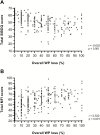High Disease Burden Drives Indirect Costs in Employed Inflammatory Bowel Disease Patients: The WORK-IBD Study
- PMID: 32378704
- PMCID: PMC7885332
- DOI: 10.1093/ibd/izaa082
High Disease Burden Drives Indirect Costs in Employed Inflammatory Bowel Disease Patients: The WORK-IBD Study
Abstract
Background: Work productivity (WP) loss includes absence from work (absenteeism) and productivity loss while working (presenteeism), which leads to high indirect costs in inflammatory bowel disease (IBD). Prior health economic analyses predominantly focused on absenteeism. Here we focus on presenteeism and assess predictors of WP loss, fatigue, and reduced health-related quality of life (HRQL).
Methods: Employed IBD patients completed the following surveys: Work Productivity and Activity Impairment, Multidimensional Fatigue Inventory, and Short Inflammatory Bowel Disease Questionnaire. Predictors were assessed using uni- and multivariable regression analyses. Annual costs were calculated using percentages of WP loss, hourly wages, and contract hours.
Results: Out of 1590 invited patients, 768 (48%) responded and 510 (32%) were included. Absenteeism, presenteeism, and overall WP loss were reported by 94 (18%), 257 (50%), and 269 (53%) patients, respectively, resulting in mean (SD) annual costs of €1738 (5505), €5478 (8629), and €6597 (9987), respectively. Disease activity and active perianal disease were predictors of WP loss (odds ratio [OR] = 6.6; 95% confidence interval [CI], 3.6-12.1); OR = 3.7; 95% CI, 1.5-8.7). Disease activity and arthralgia were associated with fatigue (OR = 3.6; 95% CI, 1.9-6.8; OR = 1.8; 95% CI, 1.0-3.3)) and reduced HRQL (OR = 10.3; 95% CI, 5.9-17.9; OR = 2.3; 95 % CI, 1.4-3.8). Fatigue was the main reason for absenteeism (56%) and presenteeism (70%). Fatigue and reduced HRQL led to increased costs compared with absence of fatigue and normal HRQL (mean difference = €6630; 95% CI, €4977-€8283, P < 0.01; mean difference = €9575; 95% CI, €7767-€11,384, P < 0.01).
Conclusions: Disease activity and disease burden lead to WP loss in approximately half of the employed IBD population, driving indirect costs. Fatigue is the most important reason for WP loss.
Keywords: health economics; inflammatory bowel disease; work productivity.
© 2020 Crohn’s & Colitis Foundation. Published by Oxford University Press on behalf of Crohn’s & Colitis Foundation.
Figures





References
-
- IsHak WW, Pan D, Steiner AJ, et al. Patient-reported outcomes of quality of life, functioning, and GI/psychiatric symptom severity in patients with inflammatory bowel disease (IBD). Inflamm Bowel Dis. 2017;23:798–803. - PubMed
-
- Bernklev T, Jahnsen J, Henriksen M, et al. Relationship between sick leave, unemployment, disability, and health-related quality of life in patients with inflammatory bowel disease. Inflamm Bowel Dis. 2006;12:402–412. - PubMed
-
- Ananthakrishnan AN, Weber LR, Knox JF, et al. Permanent work disability in Crohn’s disease. Am J Gastroenterol. 2008;103:154–161. - PubMed
-
- Mandel MD, Michael MD, Bálint A, et al. Work disability and productivity loss in patients with inflammatory bowel diseases in Hungary in the era of biologics. Eur J Health Econ. 2014;15 Suppl 1:S121–S128. - PubMed
-
- van der Valk ME, Mangen M-JJ, Leenders M, et al. Risk factors of work disability in patients with inflammatory bowel disease—a Dutch nationwide web-based survey: work disability in inflammatory bowel disease. J Crohns Colitis. 2014;8:590–597. - PubMed

